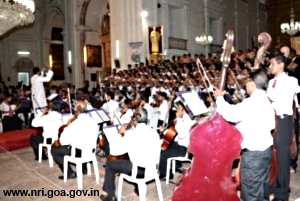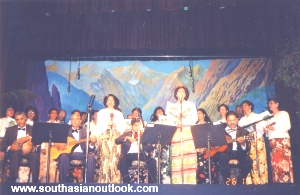How church music led to the creation of the Goan mando
 “Aare, segund konn ghaltolo?” (Who’ll sing seconds?) a perturbed elderly gentleman from among the motley group of villagers assembled around the cross in front of our house in Chinchinim, Goa, shouted out to no-one in particular.
“Aare, segund konn ghaltolo?” (Who’ll sing seconds?) a perturbed elderly gentleman from among the motley group of villagers assembled around the cross in front of our house in Chinchinim, Goa, shouted out to no-one in particular.
The cause of his agitation was the absence of my next door neighbor “Papa”, as everybody affectionately called him. He sang seconds beautifully, and without him no ladainha or community singing sounded as melodious.
This was way back in the sixties. But even today, whenever fun-loving Goans break into song, a few of them spontaneously sing seconds by ear to harmonise with those singing primeiro or the lead melody. Singing in two-part harmony or two voices is the norm, whether it’s singing Goan mandos at a family celebration, hymns in church, or litanies at village crosses.
However, singing in this way was not always a feature of our musical tradition. There was a time when our native Goan music was purely monophonic, comprising just a primary melody or voice.
It was only after the colonisation of Goa by the Portuguese that it began to incorporate music that was harmonic, that is, music in which the main melody was complemented by a back-up melody.
What was it that paved the way for this remarkable development during colonial rule? It was the church music introduced by the Portuguese in Goa.
Ancient, traditional Goan songs: Ovio and Zoti
Music was an integral part of the cultural scene in Goa much before the arrival of the Portuguese. In the pre-colonial era, the Ovi and Zoti were two of the more predominant categories of songs.
These were traditional wedding-related songs sung during pre-wedding ceremonies like the Chuddo (when the bride-to-be is taken to the house of her mama, her mother’s brother, and given colourful bangles to wear), the Ros (when the bride and groom are slathered with coconut milk before taking their bath on the day before the wedding), or when the ‘vhor‘, the bridal couple, enters the groom’s house for the first time after the nuptials and almost the entire village assembles there to scrutinise how the mother-in-law welcomes her new daughter-in-law, etc.
Too bad inquisitive neighbours often can’t fulfill their right to check out such interesting details nowadays, for rituals like these are fast becoming a thing of the past. What’s worse is that the songs that accompanied them are also fading into oblivion.
The late Lucio Rodrigues, a Professor of English Literature at the University of Bombay, and an accomplished tenor and music conductor, had described ‘dulpods‘ (folk songs like Moddgonvam tovoiaguer – At the carpenter’s shop in Margao) as a ‘meadow in the countryside’ full of ‘flowers of native scent and hue’. The same is true of ‘Ovi’s or Ovio and Zoti. The fragrance of authentic Goan culture permeates these light-hearted songs as well.
A few couplets sung during the Ros ceremony:
Rupeacho rupoi, rossan buddonu, ordeacher ghalta bessanv ti-Manu;
Tambeacho poiso addla mauxenu, ros launk ubi raulea khoxenu.
(Dipping a silver rupee coin into the coconut milk, the father’s sister blesses the bride / groom across the chest; The mother’s sister has brought a copper coin to give her blessings and is standing aside happily to apply the coconut milk.)
Ingleziche bhaxen, udkak mhonntat ‘vottor’ (2)
Tujea kazarachem, tujea kazarchem, nourea amkam zaiem mottor (2)
(The English word for ‘udok‘ is water, dear groom on the occasion of your wedding we want a motor-car.) Don’t miss the way simple village lyricists used ‘vottor‘ (pronounced as vaw-tawr) to rhyme with ‘mottor‘ (pronounced as maw-tawr)!
It’s time modern-day Goans came up with some witty Ovi lyrics of their own, don’t you think? (How about submitting your own original compositions here?)
The introduction of church music into the lives of Goan Catholics
Initially, the European Catholic priests introduced hymns and litanies in Konkani based on the style of the traditional Ovi to make them easier for the newly converted Christians to remember and sing, and thus facilitate their participation in prayer services in churches and around village crosses.
Later on, they began imparting training in western music – mainly, playing the violin, reading music, and singing – in the Parish schools (escolas paroquiais) they established in different villages.
As in other parts of India, the Christian missionaries and other religious organisations were at the forefront of spreading education in Goa as well. Gradually, the cross-cultural intermingling of European and Eastern concepts and practices led to the evolution of a hybrid culture and musical environment in Goa.
But the most notable development in the musical life of Goans was how church music led to the creation of the Goan mando as a uniquely Goan genre of music and shaped its harmonic, western-oriented musical character.
Integration of harmonies into secular Goan music
From as far back as in the 16th century, Goan Catholics were singing in church in western style, in voices. The introduction of other musical instruments like the piano, organ, and mandolin by the Portuguese, besides the violin, led to complex harmonisation and orchestral arrangements in church music in Goa.
 However, harmonisation did not spread to secular Goan music till around the 19th century. By now, talented choir masters, violinists, and composers were expanding their musical repertoire and flaunting their skills in western music.
However, harmonisation did not spread to secular Goan music till around the 19th century. By now, talented choir masters, violinists, and composers were expanding their musical repertoire and flaunting their skills in western music.
Soon Goans were drawing on their skills in western musical traditions to create a new genre of music that was their own.
But more remarkable than the influence of church music on Goan mandos was how Goan lyricists and composers took care to ensure that, despite the form of this new music being more western, the soul, that is, the content, was 100% Goan. Their Indo-Lusitanian type of songs, their mandos, were all created in their mother tongue, Konkani.
Of course, the lexicon of the Konkani spoken by Goan Catholics had begun to exhibit a more generous sprinkling of Portuguese words than that spoken by Goan Hindus.
But this had nothing to do with being servile or sycophantic. The only significance of the incorporation of Portuguese words into Konkani was that this added to the richness of the mother tongue, much in the same way that the incorporation of words from scores of languages has only enriched the English language and made it even more dynamic.
The genesis of the Goan mando
They say music runs in the blood of Goans. Given their intrinsic love of music and propensity for improvisation, it is not surprising that the genius of Goan musicians led them to synthesise western church music and their native folk music to create something so sublime, so sweetly graceful, as the Goan mando.
Moreover, the inventive musical creation of Goan Catholics represents a milestone marking the blending of Indian and western musical traditions for the first time in India. And the rest, as they often say, is history…
To round off this post, here’s a popular mando – Istimosanv Rozachem – sung in vocal harmony by ‘yours truly’ and my brother Gladwyn. Don’t forget to share the link and help keep the elegant mando tradition alive.
Sing along and enjoy!

9 Responses to Goan mandos: The influence of church music